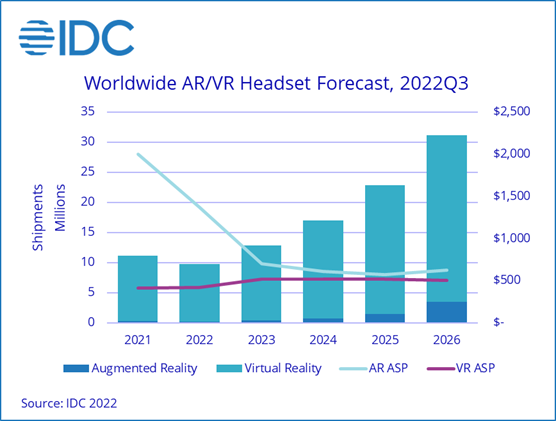Rising prices putting downward pressure on AR/VR headset shipments
Tuesday, December 20th, 2022
IDC Tracker Finds Upward Pricing Putting Downward Pressure on AR/VR Headsets
NEEDHAM, Mass. — On the backs of a tough economic environment and rising prices, International Data Corporation (IDC) has reduced its outlook for augmented reality (AR) and virtual reality (VR) headsets for the remainder of 2022 and beyond. Global shipments for AR and VR headsets will decline by 12.8% in 2022, dropping to 9.7 million units. Growth is expected to return in 2023 as shipments are forecast to jump 31.5% year over year. Sustained growth of more than 30% is also forecast for the next several years culminating in 35.1 million units shipped in 2026, according to new data from the IDC Worldwide Quarterly Augmented and Virtual Reality Headset Tracker.

Meta has long dominated the industry thanks to the accessibly priced Quest 2, which has captured 84.6% of the global AR/VR headset market during the first three quarters of 2022. The next closest competitor has been ByteDance’s Pico with 7.4% share over the same period. The top 5 list is rounded out by DPVR (1.8%), HTC (1.1%), and iQIYI (0.9%). However, each of these companies will face challenges next year as Sony’s next generation headset launches and Apple also enters the market.
“With the Quest 2 price increase and premium pricing expected for the PSVR2 and Apple’s headset, consumers will likely be more reticent with their spend in the near term,” said Jitesh Ubrani, research manager, Mobility and Consumer Device Trackers at IDC. “However, commercial growth will outpace the consumer segment in the coming years as businesses deploy VR headsets for training and other use cases and as new headsets begin to bleed into the AR territory by offering pass-through capabilities.”
AR on the other hand, is facing another round of challenges as large brands such as Shadow Creator, Mad Gaze, and even Microsoft have struggled to sustain growth. However, this will create opportunities for next generation headsets as well as new competitors to enter the AR market, although this is likely to happen in 2024 at the earliest and 2025 in earnest.
“Augmented reality has long been the domain of standalone headsets geared towards commercial use, helping to transform the way companies train their workers,” said Ramon T. Llamas, research director, Mobile Devices and AR/VR at IDC. “While these have been sophisticated in their use, the form factor has sometimes been a challenge within certain work environments. Looking ahead, we expect AR headsets to resemble and feel like more conventional eyewear and still maintain – or even surpass – the experience currently offered today.”
Links: IDC
Latest News
- Barb to start reporting TV-set viewing of YouTube channels
- SAT FILM selects multi-DRM from CryptoGuard
- Qvest and ARABSAT to launch OTT streaming platform
- ArabyAds & LG Ad Solutions partner with TVekstra in Turkey
- Freeview NZ satellite TV service to move to Koreasat 6
- Comscore expands YouTube CTV measurement internationally
